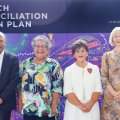Community pharmacists can improve patient health outcomes in the bush, according to a University of Queensland study.
School of Pharmacy postdoctoral research fellow Lisa Nissen and Professor Sue Tett led the project, which involved local pharmacists coordinating health services for patients living in rural and remote areas of Queensland.
Patients taking part in the study reported a significantly better quality of life and a sense of ownership over the state of their health.
And as well as providing a valuable assistance to overworked GPs, help from a friendly pharmacist could also equate to major savings in government healthcare funding.
The pharmacist-coordinated care project indicated a cost saving of about $80 per patient a year on medication and Medicare costs.
The 12-month study – funded by a $270,000 grant from the Pharmacy Guild of Australia through a Commonwealth Government agreement – was conducted in Blackall, Biloela and Stanthorpe. Local pharmacists worked in conjunction with GPs to develop a care plan for about 100 patients.
Ms Nissen said the study used the good relationship between pharmacist and patient to close the gap between the healthcare received in rural and remote populations and those in metropolitan communities.
“Rural, regional and remote populations have higher mortality and morbidity rates, higher hospitalisation rates and more health risk factors than people who live in a major city,” she said.
“Their disadvantages include not only the geographical isolation and socio-economic disparities in rural and remote areas, but also reduced access to health care providers and health services. The inequities make continuity and integration of care in these areas difficult.”
Ms Nissen said community pharmacists in regional areas were in an ideal position to aid in the integration of care for patients with complex needs.
“They are an integral part of the community, usually being small business owners with a longer duration of stay in a rural area than other health professionals, and they have a unique relationship with other health professionals and patients,” she said.
“While people taking part in the study were happy with the level of care provided by their GP, they were aware of the huge demands put on local doctors, and thought that asking them for help was bothering them.”
Ms Nissen said pharmacists visited patients in their homes to establish their healthcare needs.
These could be quite straightforward, such as linking patients up to resources such as a dietician, podiatrist and Diabetes Australia for diabetic care, and asthma groups for asthmatic patients, to more unusual requests.
“We visited a woman in her 90s in her home at Blackall and asked if there was anything she needed. She asked that we fix her mower. We said we could arrange someone to mow her lawn for her, but she kept insisting she just wanted her mower fixed.
“It turned out that she was using her mower as a walking aid, and it was easier to do when the motor was running.
“We arranged for a wheely walker and walking stick for her, and she’s now walking very well again.”
The team has applied for extra funding to extend the service to larger areas such as Charters Towers and Emerald.
Media: For further information, contact Lisa Nissen (telephone 07 3365 3195, email: l.nissen@pharmacy.uq.edu.au) or Jan King at UQ Communications (telephone 07 3365 1120 or email: communications@uq.edu.au).



